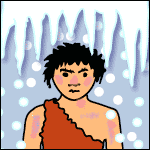Younger Dryas - the Ice Age's Last Big Blast
Created | Updated Oct 16, 2009

Nothing on Earth has quite the same effect on life and landscape as an Ice Age. It is as if millennia of growth and change are erased and wiped from the record of the Earth, never to return. Massive glaciers sweep down from higher ground, carrying with them all the underlying soil, rocks and structures that previously clung to the bedrock for generations. The huge yearly extremes of climate literally break mountains down, and many of the small rocks you see on the beach once formed parts of high mountain ranges, now long gone, or only poor imitations of their former selves.
The End of the last Ice Age
The Earth emerged from such an ice age 14,000 years ago, and for a brief period1 of about 1,300 years, things actually went quite well. Forests began to grow back and magnificent creatures such as the Irish Elk and the Woolly Mammoth flourished in the rich temperate grasslands of Europe and North America. In fact, for a time, temperatures were even warmer than they are today.
The Younger Dryas
Then, around 12,700 years ago2, the climate across North America, Europe and Western Asia suddenly reverted to bitterly freezing conditions. This period is known as the Younger Dryas3. Icecaps reappeared over high ground and the sea levels dropped. The forests and grasslands died back, and the Irish Elk and Woolly Mammoth were driven towards final extinction4. Human societies, still mainly accustomed to hunting and gathering for their sustenance, faced huge challenges as the fruits, cereals and animals on which they depended disappeared. Around this time, they adopted a new survival strategy that would enable them to live year-round, particularly during the long winter periods when absolutely no food was available. This was made possible through the intensive cultivation and nurturing of selected foodstuffs and animals close to home, an activity known today as farming. In this way, modern society was born.
Typical Climatic Conditions
The climatic conditions of mid-latitude regions during the Younger Dryas were probably similar to those of Siberia and northern Canada today. Average coastal temperatures would have ranged from -20°C in winter to no more than 10°C in summer. Further inland, the temperature range would have been even greater. Pack-ice and icebergs would have been a common ocean occurrence as far south as Spain. Violent storms and blizzards were a common feature any time between September and May.
Cold Snaps since the Younger Dryas
The worst effects of the Younger Dryas period lasted around 1300 years, but it was over by 11,000 BP (Before Present)5 and the unprecedented warm stage of the current times began. There have been a few short-lived cold snaps since: one 8000 years ago, another 5000 years ago and another 4000 years ago. There was also a cold spell in the 1700s, often termed the 'Little Ice Age', but in reality none of these periods came anywhere close to the ferocity of the Younger Dryas.
Why the Younger Dryas happened
It is believed that the Younger Dryas may have happened due to the melting of ice caps in the post-Ice Age warming period. As the ice crept back towards the polar regions of North America, the course of the meltwater began to change. Eventually the point was reached when large quantities of glacial meltwater suddenly started flooding into the seas around Newfoundland6. Fresh water and seawater do not mix well, and it is believed that the fresh water from the melting glaciers interrupted the motion of the North Atlantic Drift7, the huge current of water in the Atlantic Ocean which brings temperate conditions to Europe. The subsequent cooling occurred incredibly quickly - going from mild to freezing cold in no more than a decade or two. It appears as if the world's climate flipped suddenly over to a new stable pattern, and 1300 years later it flipped quickly back to temperate conditions for reasons not yet fully explained.
Another Ice Age in the Future?
Although humans had very little to do with the onset of the Younger Dryas, our activities today could, ironically, cause another cooling period similar to this. The current period of rapid global warming is accelerating the rate of polar melting and increasing rainfall levels in temperate regions. If all this fresh water disturbs salinity levels in the Atlantic Ocean, we could shut off the North Atlantic Drift again, and Europe could be ice-bound in as little as 10 years. If that happens, good folks of the cities and towns of Europe, you'd better get your snow shovels out.

